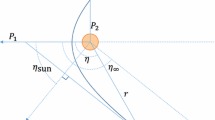Abstract
Traditionally Inertial Surveying Systems (ISS) are used for missions of30 km to 100 km length. Today, a new type ofISS application is emanating from an increased need for survey control densification in urban areas often in connection with land information systems or cadastral surveys.
The accuracy requirements of urban surveys are usually high. The loss in accuracy caused by the coordinate transfer betweenIMU and ground marks is investigated and an offsetting system based on electronic tacheometers is proposed.
An offsetting system based on a Hewlett-PackardHP 3820A electronic tacheometer has been tested in Sydney (Australia) in connection with a vehicle mountedLITTON Auto-Surveyor SystemII. On missions over750 m (8 stations,25 minutes duration,3.5 minuteZUPT intervals, mean offset distances 9 metres) accuracies of37 mm (one sigma) in position and8 mm in elevation were achieved. Some improvements to theLITTON Auto-Surveyor SystemII are suggested which would improve the accuracies even further.
Similar content being viewed by others
References
C.C. COLMAN & T.J. CRAGO: Inertial Control Surveys in Australia. Proceedings, 27th Australian Survey Congress, Alice Springs, Northern Territory, Australia, 23–29 March 1985, pp. 67–76.
J.R. GIBSON & S.E. MASRY: Application of Inertial Systems in Aerotriangulation. Proceedings of the Second International Symposium on Inertial Technology, Banff, June 1–5, 1981, pp. 451–464.
M.J. HADFIELD: Field Test Results on the Geo-Spin ESG Inertial Positioning System. Proceedings of the AIAA Guidance and Control Conference, August 11–13, 1980, pp. 242–253.
LITTON:Operator's Guide, Auto-Surveyor Dash II. Litton Guidance and Control Systems, Tactical Support and Training Department, California, 1983.
D.B. REID et al.: An Inertial Aided Photo Bathymetry System. Proceedings of the First International Symposium on Inertial Technology for Surveying & Geodesy, Ottawa, October 12–14, 1977, pp. 351–369.
J.M. RÜEGER: Experiences with an Inertial Surveying System.Vermessung-Photogrammetrie-Kulturtechnik, Vol.83, (No. 11), 1985, pp. 405–407.
J.M. RÜEGER: Evaluation of an Inertial Surveying System.The Australian Surveyor, Vol.32, (No. 2), 1984, pp. 78–98.
J.M. RÜEGER:Introduction to Electronic Distance Measurement, 2nd ed., 3rd imp., 137 pages. School of Surveying, University of New South Wales Australia, 1984.
J.M. RÜEGER: Misalignment of EDM Reflectors and its Effects.The Australian Surveyor, Vol.29 (No. 1), March 1978, pp. 28–36.
G.A. WILKINSON & R.V.C. WONG: The Use of Azimuth Control in Inertal Surveying to Improve Accuracy on an L-Shaped Traverse. Proceedings of the Second International Symposium on Inertial Technology, Banff, June 1–5, 1981, pp. 295–307.
Author information
Authors and Affiliations
Rights and permissions
About this article
Cite this article
Rüeger, J.M. High accuracy in short ISS missions. Bull. Geodesique 60, 155–167 (1986). https://doi.org/10.1007/BF02521015
Received:
Accepted:
Issue Date:
DOI: https://doi.org/10.1007/BF02521015




